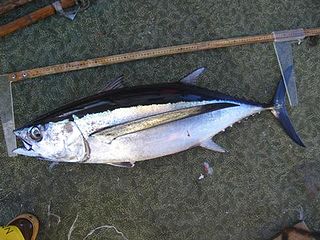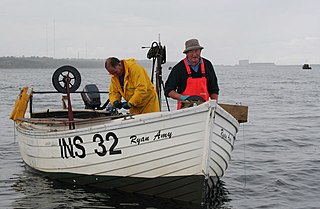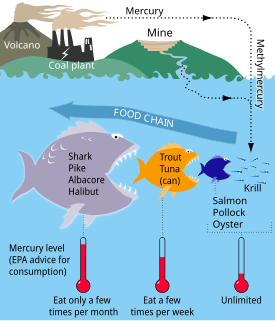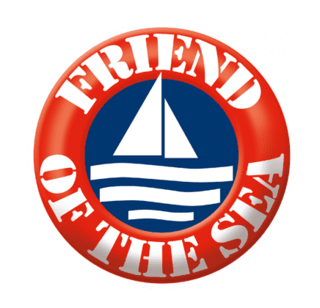
Seafood is any form of sea life regarded as food by humans, prominently including fish and shellfish. Shellfish include various species of molluscs, crustaceans, and echinoderms. Historically, marine mammals such as cetaceans as well as seals have been eaten as food, though that happens to a lesser extent in modern times. Edible sea plants such as some seaweeds and microalgae are widely eaten as sea vegetables around the world, especially in Asia.

Swordfish, also known as broadbills in some countries, are large, highly migratory predatory fish characterized by a long, flat, pointed bill. They are a popular sport fish of the billfish category, though elusive. Swordfish are elongated, round-bodied, and lose all teeth and scales by adulthood. These fish are found widely in tropical and temperate parts of the Atlantic, Pacific, and Indian Oceans, and can typically be found from near the surface to a depth of 550 m (1,800 ft), and exceptionally up to depths of 2,234 m. They commonly reach 3 m (10 ft) in length, and the maximum reported is 4.55 m in length and 650 kg (1,430 lb) in weight.

Minamata disease is a neurological disease caused by severe mercury poisoning. Signs and symptoms include ataxia, numbness in the hands and feet, general muscle weakness, loss of peripheral vision, and damage to hearing and speech. In extreme cases, insanity, paralysis, coma, and death follow within weeks of the onset of symptoms. A congenital form of the disease can also affect fetuses in the womb and may cause cerebral palsy.

The albacore, known also as the longfin tuna, is a species of tuna of the order Perciformes. It is found in temperate and tropical waters across the globe in the epipelagic and mesopelagic zones. There are six distinct stocks known globally in the Atlantic, Pacific, and Indian oceans, as well as the Mediterranean Sea. The albacore has an elongate, fusiform body with a conical snout, large eyes, and remarkably long pectoral fins. Its body is a deep blue dorsally and shades of silvery white ventrally. Individuals can reach up to 1.4 m in length.

Longline fishing, or longlining, is a commercial fishing angling technique that uses a long main line with baited hooks attached at intervals via short branch lines called snoods or gangions. A snood is attached to the main line using a clip or swivel, with the hook at the other end. Longlines are classified mainly by where they are placed in the water column. This can be at the surface or at the bottom. Lines can also be set by means of an anchor, or left to drift. Hundreds or even thousands of baited hooks can hang from a single line.This can lead to many deaths of different marine species Longliners – fishing vessels rigged for longlining – commonly target swordfish, tuna, halibut, sablefish and many other species.

Mercury poisoning is a type of metal poisoning due to exposure to mercury. Symptoms depend upon the type, dose, method, and duration of exposure. They may include muscle weakness, poor coordination, numbness in the hands and feet, skin rashes, anxiety, memory problems, trouble speaking, trouble hearing, or trouble seeing. High-level exposure to methylmercury is known as Minamata disease. Methylmercury exposure in children may result in acrodynia in which the skin becomes pink and peels. Long-term complications may include kidney problems and decreased intelligence. The effects of long-term low-dose exposure to methylmercury are unclear.

Oily fish are fish species with oil (fats) in soft tissues and in the coelomic cavity around the gut. Their fillets may contain up to 30% oil, although this figure varies both within and between species. Examples of oily fish include small forage fish such as sardines, herring and anchovies, and other larger pelagic fish such as salmon, trout, tuna, swordfish and mackerel.

Shark fin soup is a traditional soup or stewed dish served in parts of China, Taiwan, and Southeast Asia. The shark fins provide texture, while the taste comes from the other soup ingredients. It is commonly served at special occasions such as weddings and banquets, or as a luxury item.

Methylmercury (sometimes methyl mercury) is an organometallic cation with the formula [CH3Hg]+. Methylmercury is extremely toxic, and its derivatives are the major source of organic mercury for humans. It is a bioaccumulative environmental toxicant.

Many species of fish are caught by humans and consumed as food in virtually all regions around the world. Fish has been an important dietary source of protein and other nutrients throughout human history.

The escolar, Lepidocybium flavobrunneum, a species of fish in the family Gempylidae, is found in deep tropical and temperate waters around the world. It is also known as snake mackerel, walu walu, and is sometimes sold as "butterfish" or "white tuna", a matter aggravated by potential health problems related to consumption of escolar, giving rise to the mocking name Ex-Lax fish.

In the United States, the Mercury-Containing and Rechargeable Battery Management Act was signed into law on May 13, 1996. The purpose of the law was to phase out the use of mercury in batteries and to provide for the efficient and cost-effective collection and recycling, or proper disposal, of used nickel cadmium batteries, small sealed lead-acid batteries, and certain other batteries.

The 1971 Iraq poison grain disaster was a mass methylmercury poisoning incident that began in late 1971. Grain treated with a methylmercury fungicide and never intended for human consumption was imported into Iraq as seed grain from Mexico and the United States. Due to a number of factors, including foreign-language labelling and late distribution within the growing cycle, this toxic grain was consumed as food by Iraqi residents in rural areas. People suffered from paresthesia, ataxia and vision loss, symptoms similar to those seen when Minamata disease affected Japan. The recorded death toll was 459 people, but figures at least ten times greater have been suggested. The 1971 poisoning was the largest mercury poisoning disaster when it occurred, with cases peaking in January and February 1972 and stopping by the end of March.
Turtle Island Restoration Network (TIRN) is a United States 501(c)(3) non-profit organization founded in 1999 whose mission is "To take swift and decisive action to protect and restore marine species and their habitats and to inspire people in communities all over the world to join us as acmarine species advocates."
The Sea Turtle Restoration Project (STRP), founded in 1989, is a project of Turtle Island Restoration Network (TIRN), a United States 501(c)(3) nonprofit environmental organization with a goal of protecting endangered sea turtles from human-caused threats at nesting beaches and in the ocean.

The presence of mercury in fish is a health concern for people who eat them, especially for women who are or may become pregnant, nursing mothers, and young children. Fish and shellfish concentrate mercury in their bodies, often in the form of methylmercury, a highly toxic organomercury compound. The element is known to bioaccumulate in humans, so bioaccumulation in seafood carries over into human populations, where it can result in mercury poisoning. Mercury is dangerous to both natural ecosystems and humans because it is a metal known to be highly toxic, especially due to its ability to damage the central nervous system.

Friend of the Sea is a project of the World Sustainability Organization for the certification and promotion of seafood from sustainable fisheries and sustainable aquaculture. It is the only certification scheme which, with the same logo, certifies both wild and farmed seafood.

Safe Harbor Certified Seafood is the first brand developed under San Rafael, California based Micro Analytical Systems, Inc. (MASI). Seafood bearing the Safe Harbor seal is tested for overall mercury content to be under the FDA's action level of 1ppm, histamine, Escherichia coli O157:H7(E.coli O157:H7) and salmonella. Every large fin fish is individually tested by MASI personnel so the maximum mercury level in that fish does not exceed the limit set for that species. In addition, most shellfish and farmed species of catfish, shrimp and tilapia are screened for E.coli O157:H7 and Salmonella while exotic species like tuna, mahi mahi and swordfish are tested for scombroid food poisoning see histamine. Fish that are not individually tested are batch tested using an ANSI approved sampling algorithm ensuring a 95% confidence rate that the respective lot being tested falls under the Safe Harbor standard set for that species.
The following outline is provided as an overview of and topical guide to fisheries:
Seafood species can be mislabelled in misleading ways. This article examines the history and types of mislabelling, and looks at the current state of the law in different locations.















